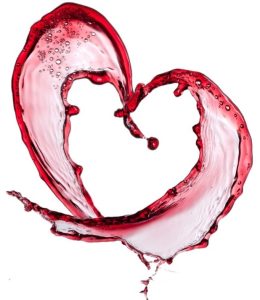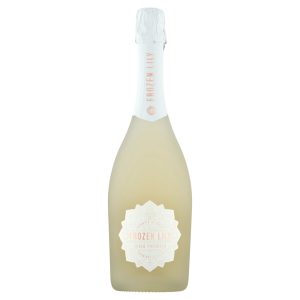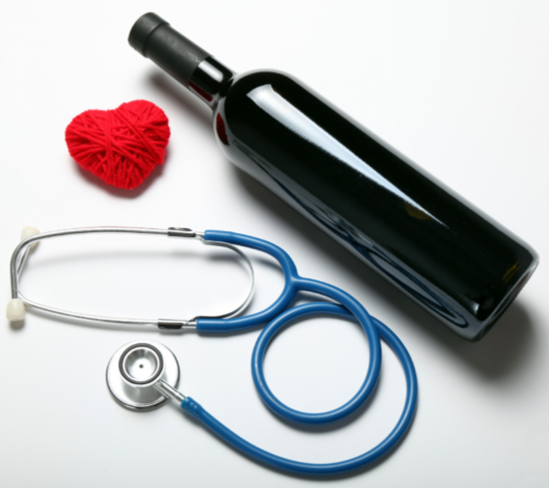I don’t imagine anyone doubts that excessive alcohol can seriously damage health.
However, we do see major over-reactions to that, probably indisputable, conclusion.
Contentions that there is “no safe level of alcohol consumption” creates a perception that total abstinence is the only answer.
As our friend Dan Farrell-Wright recently pointed out here … “ the harm vs benefits of moderate wine consumption are hotly debated and there is no scientific consensus.”
The “benefits” point is an important one.
Put crudely, modest wine drinking in convivial company can create positive emotions – and there is evidence that “happy and positive people tend to live longer”.
As ever, correlation does not imply direct causation, but it does suggest that the debate is not all one-way traffic.
One response – often suggested here – to “drink less but better” was assisted by recent studies involving Dr Lucia Billeci, of the National Research Council of Italy.
Using electrocardiogram data, she concluded that wine “generates a significant emotional response” and that one factor helping positive responses can be “attributable to the quality level of the wine tasted”.
This was tested against a control group given poor quality wine.
So, there are indeed multiple schools of thought, and they create alternative standpoints to the total abstinence approach.
Today, regular MidWeek contributor Paul takes a deeper look at the subject.
His points offer an important counterbalance to some of the click-bait headlines that appear in the press from time to time.
Here are Paul’s opening thoughts.
As a species we have been drinking alcohol for over well over 6,000 years and it is unlikely to disappear any time soon.
Over those years, there has been adaption (biological, societal and behavioural) and alcohol has become an established and integral part of European culture.
Beyond question, there are very bad health effects of excessive and prolonged chronic drinking.

However, there should be a place for sensible drinking, just as there is a place for sensible sunbathing and sensible motoring.
Few of us want to lose wine’s agreeable social context and associated mental health benefits.
Great enjoyment is derived from the relaxation, mood enhancement and life enhancing pleasure of sharing good food, good wine and good conversation.
Pleasure too comes from exploring the history, science, geography and the tales of wine makers and enthusiasts through gaining knowledge and experience of wines.
So what can we learn about preserving those benefits yet reducing the risks of harm – well let’s delve a little deeper.
What Alcohol Can Do to Your Biological Age
These are extracts from a study on the impact of binge drinking and longtime alcohol consumption on biological aging.
The principal focus of these extracts was the liver since it is the main metabolic organ of our body.
Results from the study were published in 2023 by NorthWestern University Feinburg School of Medicine.
Here are some of its conclusions:
- Previous research suggests that the liver’s regenerative capacity is greater compared to other organs, and it ages more slowly.
- However, as it ages its colour darkens and its blood flow decreases.
- Nevertheless, liver tests generally remain normal.
- Note, though, that the ability of the liver to metabolise many substances gradually decreases with ageing.
- Repair of damaged liver cells is also slower in older people.
- In addition, for people suffering from obesity, alcohol consumption increases the accumulation of excessive fat in the liver and scarring.
- Overall, liquor (generally taken to be “distilled alcoholic beverages”) and binge drinking was found to have negative effects.
- However, the study suggests that the consumption of wine has less impact on biological aging.
Suggestions to keep your liver healthy
Here are suggestions based on an interview by Sarah Rowlands in the Guardian (Jan 2025) with two hepatologists- Professor. Debbie Shawcross and Liver specialist Stephen Ryder.
- If overweight, losing weight is the best way to address fatty liver disease and reduce inflammation and scarring.
- Smoking accelerates the scarring (fibrosis), so combining smoking with heavy drinking is a very bad idea.
- Coffee, however, can be a good idea as it is an antifibrotic and two cups a day helps to prevent liver scarring.
- Exercise is also good as it moves fat out of the liver into the bloodstream and then to the muscles.
- However, don’t drink alcohol every day – have several consecutive days off in the week.
- Although “excessive” varies between individuals, be aware of the current guidance on safe drinking levels- 14 units a week so six glasses of wine over 3 days.
- Don’t drink on an empty stomach as the liver can only breakdown alcohol at about one unit an hour – but eating before and when you drink slows down the absorption.
- It is also a good idea to have an occasional glass of water to reduce dehydration and mistaking thirst for hunger.
- Similarly, it is also wise to regulate the speed of drinking alcohol and pay attention to the level of alcohol in the drinks.
- Beyond that, a Mediterranean type diet with lots of fruit, vegetables and nuts is helpful for general health.
Thank you Paul for really helpful pointers in what remains a controversial subject.
A Practical Example
Frozen Lily Asolo Prosecco (Currently £8.86 at Asda):

Picking up on that suggestion about “paying attention to alcohol levels” and Dan’s points about alcohol duty levels, here is an 11% prosecco.
Rounded with fresh orchard fruit aromas, it features soft melon, pear and peach flavours within a creamy texture.
It also has sharp acidity and a complexity and subtlety typical of its Asolo DOCG region – when compared to the greater vibrancy and crispness of Conegliano Valdobbiadene DOCG versions.
Tune in again on Monday when value at budget price points is, once more, the theme of my latest Top Tips post.









13 responses
Thanks for tate Brian, I found the article really interesting and useful.
It also validates one of my maxims which is “Everything in moderation, apart from sex”.
Cheers and have a good day!
Brian
A recent obituary of an eminent Glaswegian who lived in California quoted one of his sayings. He was an expert in health care systems.
“The French have one of the best health systems. Nothing to do with health care. They walk , drink red wine and go naked in the summer. Nothing better for your BMI.”
Greetings one and all, and thanks to Brian and Paul for that useful and interesting information.
Remember when WHO stated that there’s no safe level of alcohol consumption? Well I’ve just come across this article that puts yet another spin on things:-
https://www.irishtimes.com/science/2025/02/20/drinking-red-wine-can-protect-older-people-against-fragility-and-poor-mental-health-research-finds/
This is the link to the study itself:-
https://pure.qub.ac.uk/en/publications/flavonoid-rich-food-intake-dementia-risk-and-interactions-with-ge
Cheers!!
Gillian
Hi Brian …
That Frozen Lily Asolo Proseco can be as little as £6.64 if bought on the Asda current 25% off buy 6 bottles. We get the chance to go to Asolo too instead of C-V. Sounds good to my wife and me. Keep us hearts ‘elthy yeah? Best as ever …
Suggestions for a healthy liver, my checklist….
I’m in Spain for a month atm so there is no chance of consecutive non-alcohol days
Drinking lots of wine
Walking about 5-7 miles a day
At least two cups of strong coffee a day
Eating plenty of food (Meditteranean Diet)
Lots of water
It seems like I’m doing Ok.
Joking aside sort of, all sensible advice, everything in moderation.
Hi Brian,
Looks like there is a new M&S wine searching facility. Just received a marketing email announcing …
“Our brand-new Wine Finder tool makes choosing wines a whole lot easier, and more fun too. Take part in our Wine Finder quiz and get tailored recommendations to flawlessly suit your taste. Let’s go!”
I clicked their link, and eventually you can find a pretty good wine searching facility. They don’t initially give prices, but you can then select your local store, and this gives the price – which I assume means that it will be stocked in that store.
Navigating to the Wine Search facility, via the M&S home page, was a bit clunky. But here is a direct link …
https://www.marksandspencer.com/food/l/drinks/alcoholic-drinks/wine
I think the M&S wine offering has improved a lot recently, so nice to be able to browse their aisles, and spot offers, from home.
Thanks. Great recommendation Richard. I agree that M&S wine choices have improved recently and they have some interesting and distinct lines such as The Expressions Series, M&S Found, M$S Collection etc. And I can confirm the link you gave works. In fact, given what I had just posted below about Mid Strength wines, I’ve just used it to search their No and Low Alcohol range. Sadly, in this regard rather disappointing. Nothing in the 5.5 – 10% abv range?? Perhaps a misguided IMO commercial decision NOT to jump on this trend!
The link got removed, so try via Food, Food Inspiration Home, How To Choose Wine, and you should get there.
I don’t think any of us would be interested and engaging with the MWW website if, for whatever reason, we were moving towards total abstinence but, rather than committing to drinking less but better, I wonder whether lower alcohol products deserve more attention. There are 2 options here: drinking wines that are traditionally lower in alcohol (e.g. from Germany or Austria, Vinho Verde, Lambrusco etc) and being a little more adventurous and exploring the current proliferation of so-called ‘mid strength’ wines. As I understand it mid-strength is generally understood to be between 5.5% and 10% abv.
Like many people I initially recoiled from mid-strength wines believing them to be a) over-manipulated and b) only available as ‘watered down’ versions of big commercial brands such as 19 Crimes, McGuigan etc More recently though I have been extending my research. I have been reasonably impressed by ‘The ‘Doctors’ Marlborough Sauv Blanc and ‘The Doctors’ Marlborough Riesling from Majestic (respectively 9.5% and 9.0%). And fired by these discoveries I decided to compare Sainsbury’s Mid Strength Coolwater Bay Marlborough Sauvignon Blanc Taste the Difference (9.5%) with their ‘normal’ Coolwater Bay Marlborough Sauvignon Blanc Taste the Difference (12.5%). Both are produced by Yealands. Sadly, `I found the lower strength wine very bland in comparison.
But Sainsburys also sell a couple of interesting mid strength wines that have so far eluded me. Elia Cötes de Gascogne 9.0% (100% Colombard made by the Plaimont Cooperative) and Sainsburys Mid Strength Val de Loire Blanc, Taste the Difference 8.5% (made from 100% Grolleau Gris). As I chase them down can anyone offer feedback on either of these?
Perhaps keeping our guts healthy is also a benefit?
By no means all bad news!
“Certain polyphenols found in grapes, berries and tea have been shown to enhance microbial diversity; to boost polyphenol intake, include berries, dark chocolate (minimum 70 per cent cocoa), green tea, coffee, extra virgin olive oil, nuts, pomegranates and colourful vegetables such as red onions and purple cabbage in your diet.
Grapes, in particular, are rich in polyphenols like resveratrol and anthocyanins, with red wines contain higher levels due to their fermentation with grape skins. While red wine can provide some polyphenols, excessive alcohol intake can disrupt gut bacteria, so the best advice for gut health is to drink in moderation and stay hydrated.”
Rob Howson Nutritionist in the Independent recently.
Hiya!
And thanks to Paul and Brian – and everyone else! Very informative and interesting.
Do people when WHO stated that there’s no safe level of alcohol consumption? Well I’ve just come across this article that puts yet another spin on things:-
https://www.irishtimes.com/science/2025/02/20/drinking-red-wine-can-protect-older-people-against-fragility-and-poor-mental-health-research-finds/
Sorry about that! Wondering if typing the link like this will work….
irishtimes.com/science/2025/02/20/drinking-red-wine-can-protect-older-people-against-fragility-and-poor-mental-health-research-finds/
If it didn’t, The Irish Times has an article summarising a study suggesting that a flavonoid-rich diet can protect older people against fragility and poor mental health. Red wine happens to be flavonoid-rich!! (as well as apples, tea, berries, onions etc).
Hello Gillian,
The link worked fine for me and thank you for highlighting a fascinating article.
There is good news about sensible drinking,not least the mild protective effect against cardiovascular incidents- which rather contradicts the WHO blanket abstinence statement .
I bemoan the use of dodgy statistics and poor science by the neo-prohibition movement. Something I might return to!